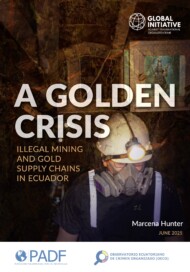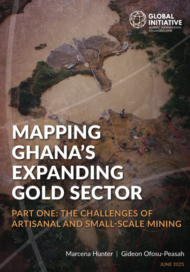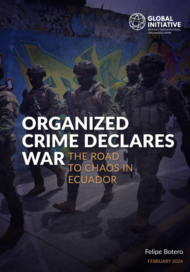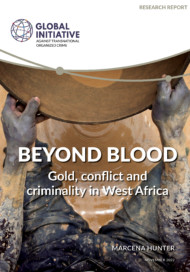In recent years, Ecuador’s gold sector has transformed dramatically. Once a largely informal livelihood, artisanal and small-scale gold mining (ASGM) has evolved into a criminally exploited industry. This report investigates this transformation and the illicit gold supply chains that are fueling it.
Drawing on interviews, fieldwork, and open-source analysis, the report examines how systemic vulnerabilities have enabled organized crime groups (OCGs) to capture sections of the ASGM sector and launder gold and illicit finance into formal supply chains. With limited government oversight, widespread corruption, and a culture of impunity, Ecuador’s gold sector has become a major source of income for OCGs, alongside growing violence, environmental degradation, and financial crime.
The report focuses on the critical gold processing hubs of Zaruma and Portovelo, in El Oro province. Gold extracted from across the country is transported to Portovelo for processing, where lax regulation, unclear ownership of processing plants, and non-transparent export practices allow illegal gold to enter international markets. The absence of effective assay systems and weak customs enforcement contributes to significant export irregularities.
Trade data reveals that the United Arab Emirates and India are now major recipients of Ecuadorian gold, yet discrepancies in reported volumes raise concerns about undeclared or falsely declared exports. Furthermore, Ecuador’s ports—particularly Guayaquil and Puerto Bolívar—are vulnerable points in this supply chain, with data on both gold doré and gold concentrate exports raising concern.
Meanwhile, environmental harms continue to mount. Cyanide and mercury pollution from reprocessed tailings in Portovelo and Zaruma are contaminating rivers, killing aquatic life, and contributing to cross-border tensions with Peru. Despite the 2015 ban on mercury use, its clandestine application persists in ASGM.
The report also outlines the expansion of OCGs into gold mining, especially groups like Los Lobos, who extract, extort and control mine sites and processing plants. Extortion payments, locally called ‘vaccinations’, are common. High homicide rates in mining areas such as Camilo Ponce Enríquez and Orellana reflect the violence accompanying this criminal convergence.
Recommendations include stronger financial transparency, making public processing plant registrations, enforcing national gold traceability systems, and improved port and export monitoring. The report calls for increased support for specialized law enforcement task forces, anti-corruption investigations, central bank gold buying schemes, and enhanced community engagement to promote resilience and formalization in the sector.
Una crisis dorada: Minería ilegal y cadenas de suministro del oro en Ecuador
En los últimos años, el sector del oro en Ecuador ha experimentado una transformación radical. La minería artesanal y de pequeña escala (MAPE), antes una actividad en gran medida informal, se ha convertido en una industria explotada por el crimen organizado. Este informe analiza dicha transformación y las cadenas de suministro ilícitas de oro que la alimentan.
Basado en entrevistas, trabajo de campo y análisis de fuentes abiertas, el informe examina cómo las vulnerabilidades sistémicas han permitido que grupos de crimen organizado (GCO) se apoderen de partes del sector MAPE, utilizando el oro y las finanzas ilícitas para ingresar a las cadenas de suministro formales. Ante la escasa supervisión estatal, la corrupción generalizada y una cultura de impunidad, el sector aurífero ecuatoriano se ha convertido en una importante fuente de ingresos para estos grupos, lo que ha venido acompañado de un aumento de la violencia, degradación ambiental y crimen financiero.
El informe se centra en los principales centros de procesamiento de oro en Zaruma y Portovelo, en la provincia de El Oro. El oro extraído en distintas partes del país se transporta a Portovelo para su procesamiento, donde la escasa regulación, la falta de claridad sobre la propiedad de las plantas y prácticas opacas de exportación permiten que el oro ilegal acceda a los mercados internacionales. La ausencia de un sistemas de análisis y ensayo eficaces y el débil control aduanero contribuyen a irregularidades significativas en las exportaciones.
Los datos comerciales muestran que los Emiratos Árabes Unidos y la India se han convertido en principales destinos del oro ecuatoriano, pero las discrepancias en los volúmenes reportados generan preocupación por exportaciones no declaradas o declaradas de forma fraudulenta. Además, los puertos ecuatorianos—en particular Guayaquil y Puerto Bolívar—son puntos vulnerables dentro de esta cadena de suministro, y los datos sobre exportaciones de oro doré y concentrado de oro también generan alertas.
Mientras tanto, los daños ambientales siguen en aumento. La contaminación por cianuro y mercurio proveniente del reprocesamiento en Portovelo y Zaruma está afectando los ríos, matando la vida acuática y alimentando tensiones transfronterizas con Perú. A pesar de la prohibición del uso de mercurio impuesta en 2015, su aplicación clandestina sigue presente en la MAPE.
El informe también documenta la expansión de los GCO en la minería de oro, especialmente grupos como Los Lobos, que extraen, extorsionan y controlan sitios mineros y plantas de procesamiento. Los pagos de extorsión, conocidos localmente como “vacunas”, son frecuentes. Las elevadas tasas de homicidios en zonas mineras como Camilo Ponce Enríquez y Orellana reflejan la violencia asociada con esta convergencia criminal.
Las recomendaciones del reporte incluyen fortalecer la transparencia financiera, hacer públicos los registros de plantas de procesamiento, aplicar sistemas nacionales de trazabilidad del oro y mejorar la supervisión portuaria y de exportaciones. El informe también aboga por mayor apoyo a unidades especializadas de seguridad, investigaciones anticorrupción, esquemas de compra de oro por parte del banco central y una mayor participación comunitaria para fomentar la resiliencia y la formalización del sector.





